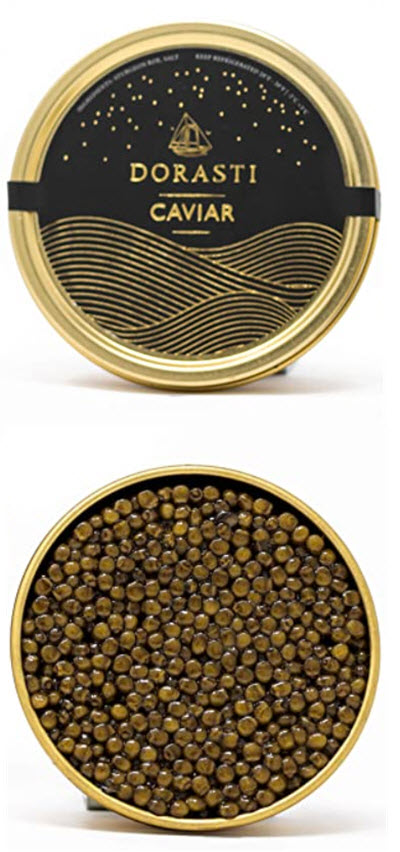Kaluga hybrid caviar
Kaluga hybrid caviar is chiefly produced in China, where the hybrids are spawned and raised in captivity. In countries with lax laws regarding the marketing of different types of roe, Kaluga hybrid caviar is sometimes sold under the name River Beluga.
 While real Beluga caviar comes from the Beluga sturgeon (Huso huso), the Kaluga hybrid fish was created by breeding the two sturgeon species Kaluga sturgeon (Huso dauricus) and Amur sturgeon (Acipenser schrenckii) with each other. Both species are native to the Amur river in China and Russia. This river is home to a variety of large predatory fish, and the Kaluga sturgeon – also known as the River Beluga – is the biggest of them all. The largest known specimens were around 5.6 metres long and the heaviest ones weighed up to 1,000 kg. The Amur sturgeon is significantly smaller than this, but still a really big fish, as the largest caught specimens weighed around 190 kg.
While real Beluga caviar comes from the Beluga sturgeon (Huso huso), the Kaluga hybrid fish was created by breeding the two sturgeon species Kaluga sturgeon (Huso dauricus) and Amur sturgeon (Acipenser schrenckii) with each other. Both species are native to the Amur river in China and Russia. This river is home to a variety of large predatory fish, and the Kaluga sturgeon – also known as the River Beluga – is the biggest of them all. The largest known specimens were around 5.6 metres long and the heaviest ones weighed up to 1,000 kg. The Amur sturgeon is significantly smaller than this, but still a really big fish, as the largest caught specimens weighed around 190 kg.
Both Kaluga sturgeon and Amur sturgeon are critically endangered in the wild, and the caviar derived from farmed kaluga hybrids is marketed as a sustainable alternative to buying caviar coming from wild sturgeons.
Kaluga and Amur sturgeons are both listed as Critically Endangered on the IUCN Red List 3.1. This is the most severe category for endangered species; the next step would be Extinct in the Wild.
Eating kaluga hybrid caviar
- The eggs are firm and rather big, but smaller than Beluga sturgeon eggs.
- The eggs are pearlescent and can vary in colour from light golden green to a gray that is so dark it almost looks black.
- Kaluga hybrid caviar has a rich, creamy and buttery taste, balanced by the right amount of saltiness.
Kaluga sturgeon (Huso dauricus)
- Order: Acipenseriformes
- Family: Acipenseridae
- Genus: Huso
- Species: Huso dauricus
This is a species of sturgeon that migrates from saltwater to the freshwater river when it is time to spawn. Kaluga sturgeons spawn in the lower reaches of the Amur River, where the current is strong and the bottom is gravel or sandy-gravel. The peak of the spawning period is late-May to July.
Water temperature impacts how early a young female will become ready to spawn for the first time, and during warm years, the females attain sexual maturity a year younger. Both males and females spawn many times during their lifetime; they are not the type of fish that die soon after spawning.
The main reason behind the decline of the Kaluga sturgeons in the wild is overfishing for the caviar market. Since a Kaluga sturgeon needs to be fairly old to reproduce, the species is extra volnurable to overfishing. Another factor that has contributed to the decline of the Kaluga sturgeon is river pollution. The eggs are especially sensitive to certain pollutants, which causes deformed eggs and birth defects.
In 1881, the official catch record for Kaluga sturgeon was 595 tons. By 1991, it had dropped to 89 tons.
Amur sturgeon (Acipenser schrenckii)
- Order: Acipenseriformes
- Family: Acipenseridae
- Genus: Acipenser
- Species: Acipenser schrenckii
The male Amur sturgeon reaches sexual maturity around 7-8 years of age, while the females needs to be 9-10 years old. Amur sturgeons can live for at least 65 years, but old specimens are rare today due to the overfishing.
The Amur sturgeon is a benthic species that feeds chiefly on aquatic insect larvae, bone fish and molluscs.
The Amur sturgeon spend a lot of time in the brackish waters found at the mouth of the Amur River, but will migrate up into fresher water to spawn. They start migrating in autumn, and will spend the winter close to the spawning locations. The actual spawning does not take place until the water gets warm, typically in May and June when the water temperature is 15-20 degrees C. The Amur sturgeons spawn where the water current is strong and the bottom is gravel or sandy-gravel.
